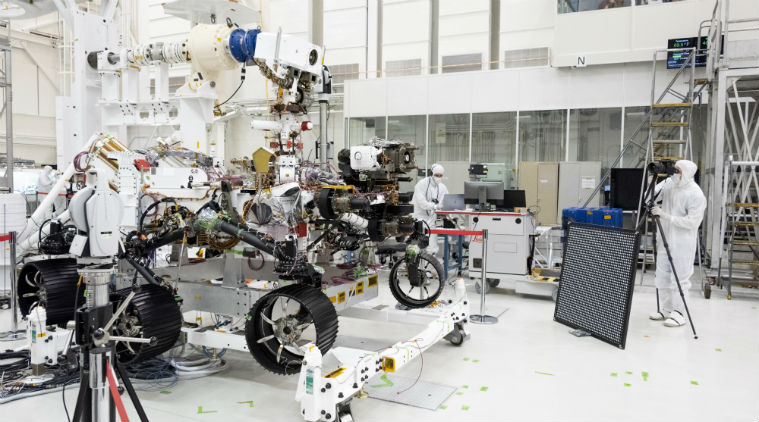
NASA’s Mars 2020 rover, which is set to be launched next year, recently underwent an ‘eye’ examination following the installation of several cameras into it. The rover now comes with a fleet of imaging capabilities from wide-angle landscape cameras to narrow-angle high-resolution zoom lens cameras, the US space agency said.
The agency has completed the calibration of the forward-facing cameras on the rover, This measurement is very important for accurate ‘stereo vision’, which is a key capability of the vehicle, according to Justin Maki, Chief Engineer for Imaging and the Imaging Scientist for Mars 2020 at the space agency’s Jet Propulsion Laboratory (JPL).
“We tested every camera on the front of the rover chassis and also those mounted on the mast,” Maki said in a statement adding that “Characterizing the geometric alignment of all these imagers is important for driving the vehicle on Mars, operating the robotic arm and accurately targeting the rover’s laser,”.
For performing the calibration, the Mars 2020 rover team imaged target boards that come with grids of dots and are placed at a distance which ranges from 1-44 yards (or 1-40 meters) away. The target boards were used for confirming that the cameras installed in the rover met the agency’s requirements for resolution and geometric accuracy. The cameras which were tested include two Navcams, four Hazcams, a SuperCam and two Mastcam-Z.
The space agency has informed that the cameras on the back of the rover’s body and on the turret at the end of the rover’s arm will undergo a similar calibration in the coming weeks.
The Navcams ( or navigation cameras), which is mounted on the remote sensing mast of the Mars 2020 rover will be capturing panoramic 3D image data that will support its route planning, robotic-arm operations, drilling and sample acquisition.
These Navcams can work along with Hazcams (or hazard-avoidance cameras) which are placed on the lower portion of the Mars 2020 rover’s chassis to provide a complementary view of the terrain so as to safeguard the rover against crashing into unexpected obstacles or getting lost. these will be used by software which will make the Mars 2020 rover self-drive over the Mar’s terrain.
The SuperCam will be examining rocks and soil on the red planet, looking for organic compounds which could be related to past life on Mars. The two Mastcam-Z high-resolution cameras will be working together as a multispectral, stereoscopic imaging instrument to boost the rover’s driving and core-sampling capabilities. These cameras will also allow the science team members to observe the details in rocks and sediment across any location within the field of view of the rover.
NASA says that it will use Mars 2020 and other missions, including to the Moon, to prepare for human exploration of Mars. The space agency intends to establish a sustained human presence on and around the Moon by 2028 through NASA’s Artemis lunar exploration plans.
Also Read|NASA’s GLIMR space instrument to study coastal ecosystems
NASA is also asking people to submit their names for traveling to Mars with the Mars 2020 mission and get a souvenir boarding pass to the neighbouring planet.